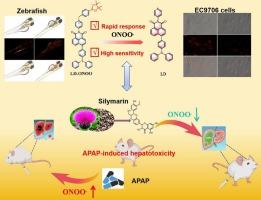A rapid-response red-emitting probe for peroxynitrite fluctuation and silymarin protection in drug-induced hepatotoxicity
IF 4.7
2区 医学
Q1 BIOCHEMISTRY & MOLECULAR BIOLOGY
引用次数: 0
Abstract
Drug-induced liver injury (DILI) is a clinically important condition caused by hepatotoxic drugs or their reactive metabolites, frequently linked to excessive reactive oxygen species (ROS) generation. Given the pivotal role of peroxynitrite (ONOO−) in oxidative stress-mediated DILI progression, real-time tracking of its spatial-temporal dynamics is critical for mechanistic studies. We present a red-emitting fluorescent probe, LD-ONOO, engineered with a naphthylamide-based fluorophore and a phenylboronic acid pinacol ester as the ONOO−-specific trigger. This probe demonstrates ultrafast response kinetics (<30 s), a remarkably large Stokes shift (163 nm), and exceptional selectivity and sensitivity for ONOO− over competing ROS. LD-ONOO enabled real-time monitoring of endogenous ONOO− fluctuations in both cellular and zebrafish models. In vivo imaging in a DILI mouse model revealed pronounced ONOO− upregulation, directly implicating its pathological role. Notably, silymarin treatment effectively normalized ONOO− levels, demonstrating the therapeutic potential of this traditional Chinese medicine-derived compound in mitigating DILI. Our study not only delivers a versatile molecular imaging tool for investigating ONOO−-associated hepatotoxicity but also provides experimental validation for the application of natural compounds in DILI intervention strategies.

过氧亚硝酸盐波动和水飞蓟素在药物性肝毒性中的保护作用的快速反应红色探针
药物性肝损伤(Drug-induced liver injury, DILI)是由肝毒性药物或其反应性代谢物引起的一种临床重要疾病,通常与活性氧(reactive oxygen species, ROS)产生过多有关。考虑到过氧亚硝酸盐(ONOO−)在氧化应激介导的DILI进展中的关键作用,实时跟踪其时空动态对于机制研究至关重要。我们提出了一种红色荧光探针,LD-ONOO,采用萘酰胺基荧光团和苯硼酸蒎醇酯作为ONOO特异性触发器。该探针具有超快的响应动力学(30秒),非常大的Stokes位移(163 nm),以及对ONOO−的选择性和灵敏度优于竞争ROS。LD-ONOO能够实时监测细胞和斑马鱼模型中的内源性ONOO−波动。DILI小鼠模型的体内成像显示明显的ONOO -上调,直接暗示其病理作用。值得注意的是,水飞蓟素治疗有效地使ONOO−水平正常化,证明了这种中药衍生化合物在缓解DILI方面的治疗潜力。我们的研究不仅提供了一个多功能的分子成像工具来研究ONOO−相关的肝毒性,而且为天然化合物在DILI干预策略中的应用提供了实验验证。
本文章由计算机程序翻译,如有差异,请以英文原文为准。
求助全文
约1分钟内获得全文
求助全文
来源期刊

Bioorganic Chemistry
生物-生化与分子生物学
CiteScore
9.70
自引率
3.90%
发文量
679
审稿时长
31 days
期刊介绍:
Bioorganic Chemistry publishes research that addresses biological questions at the molecular level, using organic chemistry and principles of physical organic chemistry. The scope of the journal covers a range of topics at the organic chemistry-biology interface, including: enzyme catalysis, biotransformation and enzyme inhibition; nucleic acids chemistry; medicinal chemistry; natural product chemistry, natural product synthesis and natural product biosynthesis; antimicrobial agents; lipid and peptide chemistry; biophysical chemistry; biological probes; bio-orthogonal chemistry and biomimetic chemistry.
For manuscripts dealing with synthetic bioactive compounds, the Journal requires that the molecular target of the compounds described must be known, and must be demonstrated experimentally in the manuscript. For studies involving natural products, if the molecular target is unknown, some data beyond simple cell-based toxicity studies to provide insight into the mechanism of action is required. Studies supported by molecular docking are welcome, but must be supported by experimental data. The Journal does not consider manuscripts that are purely theoretical or computational in nature.
The Journal publishes regular articles, short communications and reviews. Reviews are normally invited by Editors or Editorial Board members. Authors of unsolicited reviews should first contact an Editor or Editorial Board member to determine whether the proposed article is within the scope of the Journal.
 求助内容:
求助内容: 应助结果提醒方式:
应助结果提醒方式:


